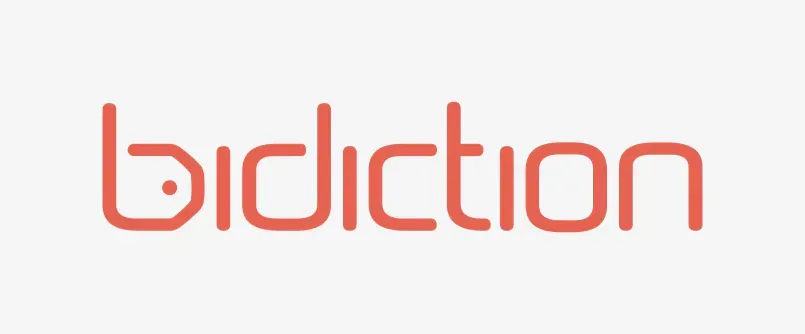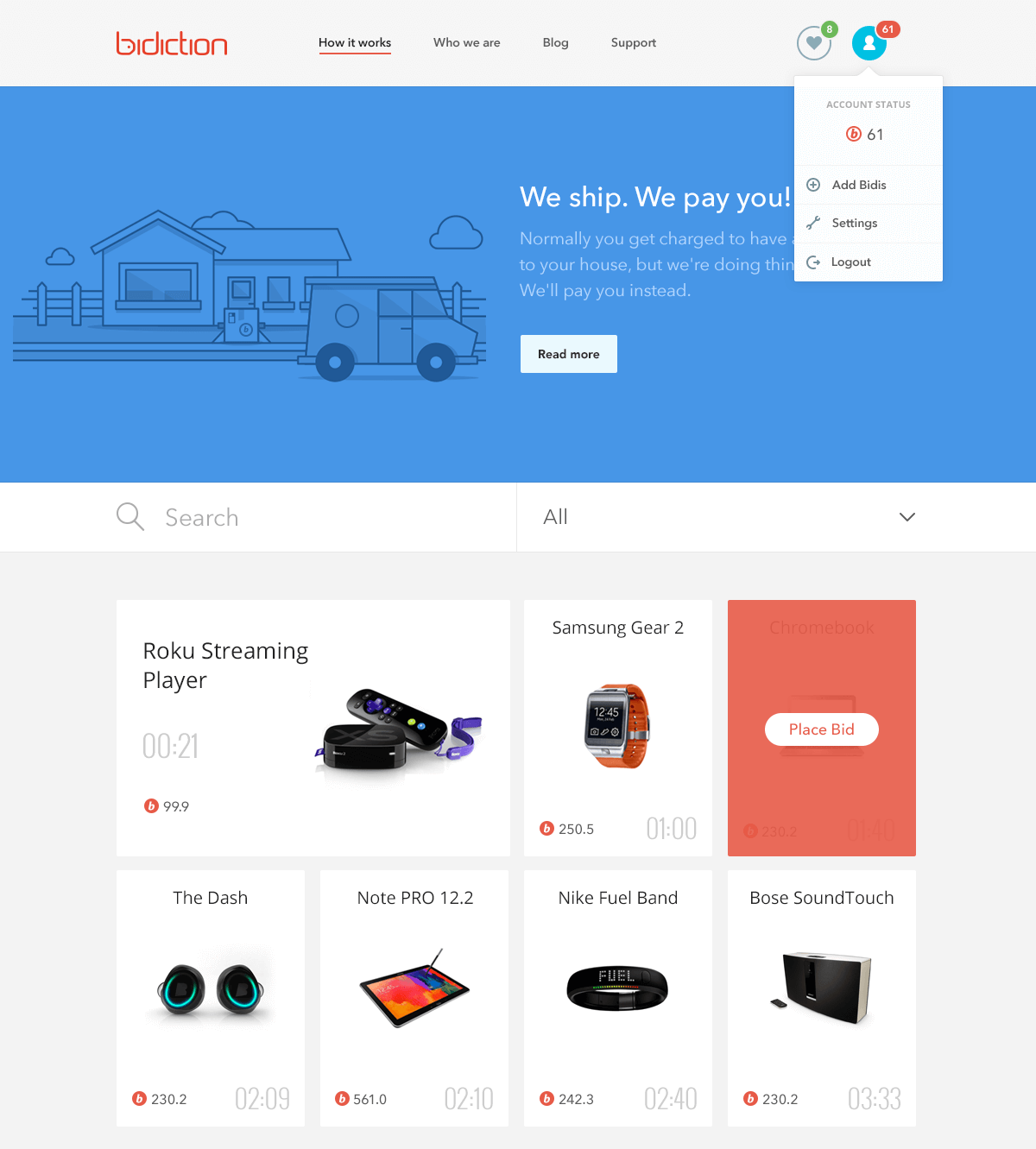Bidiction Was A “Revolutionary” Way To Buy And Sell Online

Buying and selling items online is frustrating.
Amazon nails the online shopping experience; it’s quick and convenient. Amazon’s users want to get in and out, but the process is lost on those who like the adrenaline rush associated to bidding and getting a good deal.
What about the person who wants a frictionless way to unload old items, buy new items with those funds, and participate in a fast moving auction with a chance to get a great deal?
Kind of sounds like eBay, right?
eBay offers the excitement of auctions and good deals, but you’re faced with huge problems.
It’s hard to make the consumer-to-consumer (C2C) model work. Few merchants have businesses, marketing, shipping, communication, and returns, which creates fiction. Most are occasional sellers with minimal business smarts.
What about penny auctions?
Penny auction sites are very confusing. Basically, you pay a fixed non-refundable fee for each bid (i.e. $0.60 for one bid). Every time you bid, the price of the item goes up a penny while 10 seconds is added to the clock. The last person who bids wins the item.
While you just won a TV for $40.02, the TV was 4,002 bids and cost a combined $2,401.20 for all users who bid (assuming $0.60 per bid). The last participant bid wins the item and pays the final bid price (a lot of bidders are out of money). Penny auctions are very profitable for the business.
The penny auction model is fun and you can get good deals. However, it’s only profitable because people get deceived by the low prices and don’t fully understand the concept. Some penny auction sites use unethical practices, employing bots to get prices up. There is no assurance you’re bidding against real people.
As you can see, the buying and selling process is not ideal.
It’s a poor selling experience, and if you’re looking for the thrill of bidding, it’s a poor buying experience.
What should change?
eBay has a monopoly on the bidding market. They can get away with anything, including huge fees, terrible customer service, bad web design, and pages loaded with ads. If sellers want maximum exposure, eBay’s the only place.
Auction sites are tough to start because you need a large number of active users for it to be profitable. It’s hard to acquire a large user base from nothing while staying ethical and not using bots.
This is where Bidiciton comes in. Bidiction is a brainchild of mine. It’s not going to launch but I wanted to share my strategy.
How would Bidiction work?

- You send your old item to Bidiction, and based on the condition of the item, you get bids to use.
- You can buy additional bids for $1 each.
- Prices start at 70% of retail value and go down 10 cents each bid (i.e. a phone that retails at $500 will have a starting price of $375 and go down each time someone bids).
- The last person to bid wins the item at that price.
- Bids are non-refundable, but you have a shot to buy every item for the retail price minus the price spent on bids (i.e. You place 40 bids on a phone worth $500, but didn’t win. We’ll sell it to you for $460).
- You either get the item cheap or you get the item for retail while having a fun experience.
How would Bidiction be different?
- Bring trust, ethics, and legitimacy back while offering the consumer a chance to get a great deal. Everything is run by a real business (i.e. Bidiction) and not the consumer. It’s a well designed, legitimate alternative. Design is sleek and professional; branding is catchy.
- Social login (i.e. Facebook) with your profile picture to assure you’re bidding against real humans.
- Allow people to trade their old tech and items to receive bids in return.
- Less confusing currency than other penny auctions.
- No bid “Packages.” People buy as many bids as they want; they’re not limited to packages of 25, 30, 50, etc.
- Prices for items are set. This prevents people from paying way more than an item is worth, and introduces different strategies into the bidding process.
- Items begin at a discount, so the winner always gets things cheaper. Bids go down instead of up.
- You can buy the item at retail, even if you lose.
How would Bidiction be profitable?
Profits come from people who place a few bids, but don’t win the item or want to buy it after they’ve lost, bidders who treat the auction like the lottery (I probably won’t win, but let’s throw down a few bucks and see if I get lucky.)
What did the Bidiction’s buyer persona look like?
- Existing penny auctioneers: Extreme deal hunters who thrive on getting something for cheap or free. They know the system and are easily motivated by vouchers/deals/packages.
- Deal hunters: People who go hunting for coupon codes and glitches in the system. They’re price-sensitive, but other than the communities they participate in, they have no allegiances. They are attracted to a deal too good to pass up.
- Online auctioneers: People familiar with eBay and are comfortable buying online. They’ve never used penny auction systems before, but with the right help and incentives, could get hooked.
How would Bidiction break into the market?
- Reviews: They hit the mid-to-bottom-of-funnel customer well.
- Cross-promotion: Convince innovative, up-and-coming businesses to partner and promote the deal. For example, talk with Hello about selling their sleep tracker and promoting it to their community.
- Pitch Tech Blogs: Share traffic with big tech blogs.
- Contests: These are great for initial engagement; they give something to promote across social networks and during cross promotion efforts. However, people who sign up for contests will need to become long-term bidders and customers. Otherwise, you run the risk of having to host contests without gaining long-term traction. We need other content infrastructure in place (e-mail newsletters/drips, social, explainer videos, etc.) to snag new people and keep them.
- User-Generated Content: This would provide social proof and could come in the form of video, photos of the winners, and customer reviews. (It’s basically showing: Yes, people really win. Yes, here’s what they’re winning. It could be YOU! – Sort of like the lottery commercials. You want to share in someone’s success and feel like it could be yours). Users aren’t going to provide this for free, so we would have to incentivize them by giving away free bids. One problem with user-generated content is that we lose the ability to control 100% of the message , and quality control is tough.
Conclusion
Bidiction is not something I can do without huge funding and economies of scale, but it’s fun to strategize. (Read part two.)
None of these ideas have been validated, and I don’t know if they would work with venture capital. I do know there is plenty of room to improve online auctions.
What do you think?
How can online auctions be improved?
Who’s going to step up to the plate?




